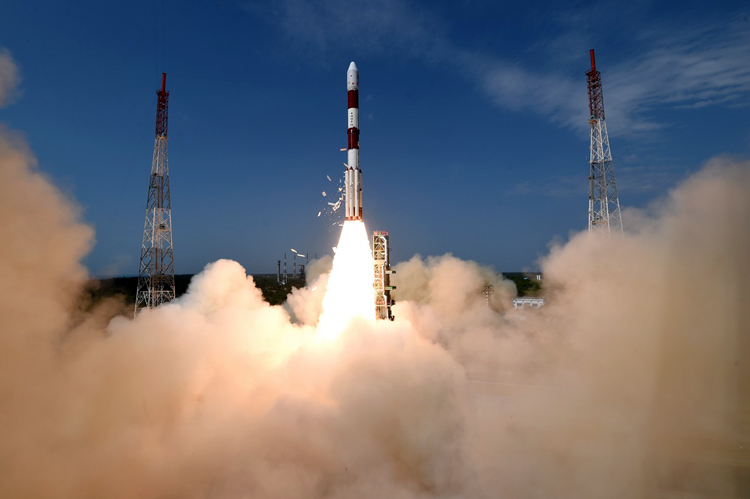INDIAN ARMED FORCES CHIEFS ON
OUR RELENTLESS AND FOCUSED PUBLISHING EFFORTS

SP Guide Publications puts forth a well compiled articulation of issues, pursuits and accomplishments of the Indian Army, over the years

I am confident that SP Guide Publications would continue to inform, inspire and influence.

My compliments to SP Guide Publications for informative and credible reportage on contemporary aerospace issues over the past six decades.
Another ISRO Milestone – more to follow
 |
By Lt. General P.C. Katoch (Retd) Former Director General of Information Systems, Indian Army |

As the Polar Satellite Launch Vehicle (PSLV) rocket's XL variant lifted off from the Satish Dhawan Space Centre, Sriharikota at 9.29 AM on June 23, carrying earth observation satellite Cartosat-2 series weighing 712 kg and 30 co-passenger satellites (29 foreign, one Indian) with its rocket, ISRO achieved yet another milestone. The countdown had actually begun at 5.29 AM watched by the whole nation. The PSLV-C38 lifted off as planned, from the First Launch Pad. After a flight of about 16 minutes, the satellites achieved a polar Sun Synchronous Orbit (SSO) of 505 km inclined at an angle of 97.44 degree to the equator (very close to the intended orbit) and in the succeeding seven and a half minutes, all the 31 satellites successfully separated from the PSLV in a predetermined sequence beginning with Cartosat-2 series satellite, followed by NIUSAT and 29 customer satellites. The total number of Indian satellites launched by PSLV now stands at 48.
The 30 satellites together weighed 243 kg and the total weight of all the 31 satellites, including Cartosat, was about 955 kg. The co-passenger satellites, launched as part of the commercial arrangements between ISRO's commercial arm, the Antrix Corporation Ltd and the international customers, comprised 29 nano satellites from 14 countries - Austria, Belgium, Britain, Chile, Czech Republic, Finland, France, Germany, Italy, Japan, Latvia, Lithuania, Slovakia, and the US as well as one Indian nano satellite. Prime Minister Narendra Modi tweeted, "Congratulations to ISRO on its 40th successful Polar satellite launch... You make us proud." ISRO chief, AK Kiran Kumar said, "Our effort of continuing to provide increased earth observation, navigation as well as communication will continue." According to the 2015 Space Foundation report, the global space industry was valued at $323 billion with India accounting for only 0.6%. But the Modi Government has given a push to boost the space business. On 14 February 2017, India placed 104 satellites in space in a single mission showcasing low-cost technology that won accolades world over. Since 1999, ISRO's PSLV has 209 foreign satellites.
More recently on June 5, 2017, India leapfrogged into a select group of nations using indigenous cryogenic technology (United states, Russia, China, Japan and the European Space Agency), successfully launching its heaviest launch vehicle (GSL V MkIII-D1), placing the country's heaviest satellite till date, GSAT-19, into precise orbit. The satellite weighed 3,136 kg, enabling launching 4-ton satellites from India that earlier could only be launched from launch pads abroad. With the successful launch of Cartosat-2E satellite on June 30, the number of satellites available to our military for mapping and surveillance both over land and sea has gone up to 13 albeit with GSAT-17 in space, India overall has 18 communication satellites now.. These include Cartosat 1 and 2 series, and the Risat-1 and Risat-2 satellites. Most of these remote-sensing satellites are placed in the near-earth orbit. Placing these satellites at the sun-synchronous polar orbit (200-1,200 km above the earth's surface) helps in better scanning of the earth.At the same time, some of these satellites have also been put in the geo orbit. Cartosat-2E is an advanced remote sensing satellite capable of providing scene-specific spot imagery; capable of accurately spotting objects within a square of 0.6 metre by 0.6 metres. The Navy also uses Gsat-7 for real-time communication among its warships, submarines, aircraft and land systems. India does have capability to develop anti-satellite weapons (ASATs), but has not done so in deference to international norms, which prohibit member space agencies from militarizing outer space. It may be recalled that China conducted an ASAT test in January 2007.
In May 2017, ISRO announced plans to advent high-speed internet in India by launching three communication satellites over the next 18 months. Of these three communication satellites, GSAT-19 has already been launched on June 5. The other two satellites will be GSAT-11 and GSAT-20. These satellites will use multiple spot beams (a special kind of transponder that operates on a high frequency) that will increase internet speed and connectivity. These multiple spot beams will cover the entire country. A spot beam is a satellite signal that is specially concentrated (sent by a high-gain antenna located on the satellite) so that it covers only a limited geographic area on earth. The narrower the beam, more is the power. The three satellites will reuse "beams" (signals) several times over smaller areas. In contrast, traditional satellite technology uses a broad single beam to cover wide regions. GSAT-11, which is heavier than GSAT-19, will be launched by end 2017; using 16 beams it will be able to transfer data at the rate of 13 gigabytes per second. Launch of GSAT-20 is planned in end 2018; using 40 beams (each with two polarizations will actually make them 80 beams) will have data rate of 60-70 gigabytes/sec. Once operational, these three satellites will be capable of providing high-quality internet, phone and video services, which will be a game changer for India. Presently, India with just 4.1 Mbps average connection speed, ranks 105 on the world's fastest internet connectivity speed list; way behind South Korea (the leader with 26.3 Mbps) and Hong Kong (20 Mbps), Sri Lanka (6 Mbps), Vietnam (6.3 Mbps) and China (5.7 Mbps).





